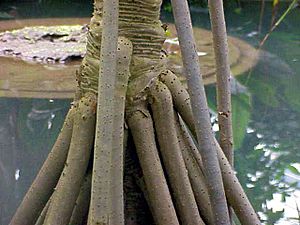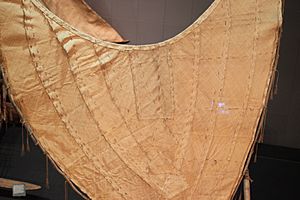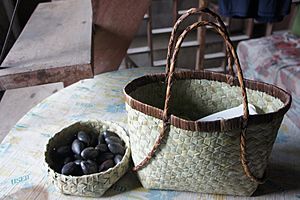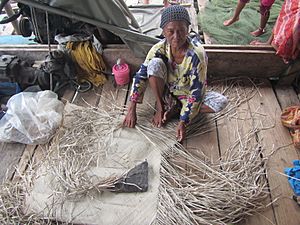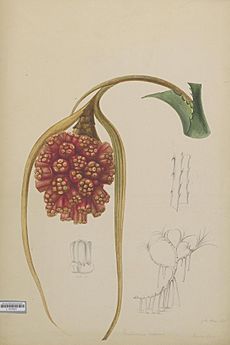Pandan facts for kids
Quick facts for kids Pandan |
|
|---|---|
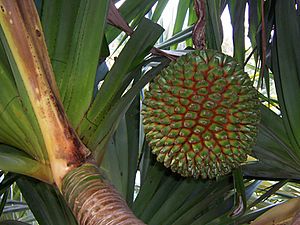 |
|
| Fruit of Pandanus utilis | |
| Scientific classification |
|
| Kingdom: | Plantae |
| Clade: | Tracheophytes |
| Clade: | Angiosperms |
| Clade: | Monocots |
| Order: | Pandanales |
| Family: | Pandanaceae |
| Genus: | Pandanus Parkinson |
| Species | |
|
See List of Pandanus species |
|
| Synonyms | |
|
|
Pandanus is a group of plants that includes about 750 different types, called species. These plants look a bit like palm trees, but they are not closely related. They are found in tropical and subtropical parts of the world, especially in Madagascar and Malesia. People often call them pandan, screw palm, or screw pine.
Contents
What Pandanus Plants Look Like
Even though they are sometimes called pandanus palms, these plants are not true palm trees. They come in many sizes. Some are small shrubs less than 1 meter (3 feet) tall. Others can grow into medium-sized trees up to 20 meters (65 feet) tall. These trees usually have a wide top, heavy fruits, and grow at a moderate speed.
The main stem, or trunk, is thick and often has many branches. It is marked with rings from old leaves. Older plants can have many branches. The trunk can be smooth, rough, or bumpy, depending on the type of pandanus.
Pandanus plants often have thick "stilt roots" that grow from the lower part of the trunk. These roots look like props and help support the plant, especially as it gets heavier with leaves, fruits, and branches. They act like anchors, keeping the plant upright and secure in the ground.
At the top of the plant, there are one or more groups of long, strap-shaped leaves. These leaves can be spiny. Their size varies a lot between species, from 30 centimeters (12 inches) to over 2 meters (6.5 feet) long. They can be from 1.5 centimeters (0.6 inches) to 10 centimeters (4 inches) wide.
Reproduction and Fruits
Pandanus plants are "dioecious." This means that male flowers and female flowers grow on separate plants. The male flowers are small, about 2-3 centimeters (1 inch) long, and smell nice. They are surrounded by narrow, white leaf-like parts called bracts.
The female plants produce flowers that turn into round fruits. These fruits are also surrounded by bracts. Each fruit is made up of many smaller parts that join together. The whole fruit looks a bit like a pineapple and is usually 10-20 centimeters (4-8 inches) across. When the fruit ripens, it changes color from green to bright orange or red. These fruits can stay on the tree for over a year!
Where Pandanus Plants Grow
Pandanus plants can grow in many different places, from sea level up to 3,300 meters (10,800 feet) high. They are very important for the people in the Pacific islands, almost as much as coconut trees. They grow naturally in coastal areas across the tropical and subtropical Pacific. They are tough plants that can handle dry weather, strong winds, and salty ocean spray.
These plants can easily grow from seeds. However, people often grow their favorite types by taking cuttings from branches. This helps them get the exact kind of pandanus they want.
The stilt roots are especially helpful for pandanus plants that grow on windy coastlines and beaches. These roots help the plants stay firmly in the loose sand. While pandanus plants are found in tropical areas worldwide, they are most common on the low islands and sandy atolls of Polynesia and Micronesia. Some types of pandanus also grow in mountains and along rivers.
Animals like bats, rats, crabs, and elephants eat pandanus fruits. But most pandanus species spread their seeds mainly by water. Their fruits can float, allowing them to travel to new islands without human help.
How People Use Pandanus
Pandanus plants have many different uses, depending on the specific type and where it grows. Some pandanus plants are a source of food, while others provide materials for making clothes, baskets, and even shelters.
Handicrafts and Weaving
The leaves of pandanus plants are widely used for making handicrafts. Artisans collect mature leaves from wild plants, making sure to leave younger leaves so the plant can grow back. The leaves are then cut into thin strips and sorted. Weavers create basic pandan mats or roll the leaves into ropes for more complex designs.
After weaving, the mats are often colored by placing them in drums with water-based dyes. Once they dry, the colored mats are shaped into finished products like placemats or jewelry boxes. Sometimes, final color touch-ups are added.
Food and Flavoring
The leaves from a specific type of pandanus, Pandanus amaryllifolius, are very popular in Southeast Asian and South Asian cooking. They give a special smell and taste to many dishes, often used with flavors like chocolate. Because of how they are used, pandan leaves are sometimes called the "vanilla of Asia."
When cooking, fresh pandan leaves are usually torn into strips, tied in a knot, and put into the liquid. They are removed at the end of cooking. You can also buy dried leaves or bottled pandan extract. In some cultures, finely sliced pandan leaves are used as fragrant confetti for special events like weddings.
In Sri Lanka, pandan leaves are a key ingredient in many vegetable and meat dishes. It's also common to add a few pieces of pandan leaf when cooking rice.
In Southeast Asia, pandan leaves are mainly used in sweet treats like coconut jam and pandan cake. In Indonesia and Malaysia, pandan is also added to rice and curry dishes, such as nasi lemak. In the Philippines, pandan leaves are often combined with coconut in desserts and drinks like maja blanca.
In Indian cooking, the leaf is added whole to biryani, a type of rice dish. This is because both basmati rice and pandan leaves contain the same special flavoring ingredient, called 2-acetyl-1-pyrroline.
Kewra is a special liquid taken from the pandan flower. It is used to flavor drinks and desserts in Indian cooking. Kewra is also used in religious ceremonies. In western India, the leaves are sometimes used to make hair decorations because of their lovely smell.
Edible Fruits and Nuts
Some pandanus species have large or medium-sized fruits that are good to eat. This includes many types of Pandanus tectorius and Pandanus utilis. The fruit can be eaten raw or cooked. However, pandanus plants with small fruits might taste bitter.
The nuts from the Pandanus julianettii plant, called Karuka nuts, are a very important staple food in New Guinea. There are over 45 known types of cultivated Karuka. During harvest time, entire families might move to be closer to the trees. The nuts taste similar to coconut or walnuts.
Across Oceania, people use almost every part of the pandanus plant. Different species are used for different things than those used in Southeast Asian cooking. Pandanus trees provide materials for building homes, making clothes and textiles (like carrying bags and fine mats), sails for boats, food, medication, decorations, and tools for fishing. They also have religious uses.
Selected Species
There are many different types of Pandanus plants. To see a full list, you can visit the List of Pandanus species page.
Some well-known species include:
- Pandanus amaryllifolius – This is the pandan plant whose leaves are used for flavoring food.
- Pandanus julianettii – This plant produces the important Karuka nuts eaten in New Guinea.
- Pandanus tectorius – Also known as the thatch screwpine, its fruits are edible and its leaves are used for weaving.
- Pandanus utilis – This is the common screwpine, also known for its edible fruit.
See also
 In Spanish: Pandanus para niños
In Spanish: Pandanus para niños


